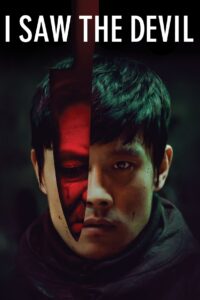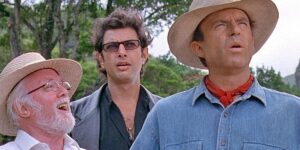You hear it often in writing circles, “Plot driven,” “Character driven,” or whatever driven.
Let’s take a look at what they mean and why it matters.
Thematically Driven
Surprise. All good fiction is thematically driven. Which is to say;
“If your personal message of the story is not interconnected to all the other elements in the story, if the theme isn’t the driving force behind them, anchoring them… guiding them… you’re in trouble.”
Far too many writers gravitate away from thematically driven work, relying solely on one of the other drivers below.
This is a bad approach, for one single reason if nothing else; structuring around a theme takes away from nothing, it only increases efficacy.
Always, work from an established Master Theme.
Plot Driven
A lot of folks write by plot.
I was watching this Korean thriller movie, “I saw the Devil…”
 Cop guy’s girl is killed by psycho serial killer, so cop guy goes on revenge rampage to totally mess up the serial killer.
Cop guy’s girl is killed by psycho serial killer, so cop guy goes on revenge rampage to totally mess up the serial killer.
There’s no concept there.
There’s no depth to the characters.
It’s literally, cop guy catches killer guy, beats the crap out of him, killer escapes, cop chases…
Rinse and repeat for 140 minutes.
Serial Killer steals car, so, this can only mean there’s gonna be a chase, OR the guy is gonna drive somewhere. This is all the plot can offer.
Serial Killer gets hurt and taken to hospital, so he can either take treatment and rest, OR kill all the doctors.
The “plot” drives the narrative.
The plot creates a set of conditions, or cause and effects, each leading the narrative to the next point in the chain. Plot driven also reflects a narrative (outside forces) acting against the protagonist, not vice versa, or in other words, a REACTIVE protagonist.
Purely plot driven is one of the least effective way to write, because it lacks depth.
Successful plot driven narratives MUST rely on interesting, engaging, plot elements. The familiar and expected kill plot driven, dead.
If you’re going to work on a plot driven piece, it better be something people haven’t seen before. It’s like opening a new roller coaster at the amusement park, if its the same dips, drops, twists and turns as every other roller coaster, no one’s coming back for a second ride.
Character Driven
All stories have characters, so people tend to mix this one up.
Character driven, is when the characters themselves drive the narrative. This is the opposite of plot driven, where outside forces act on the protagonist.
In Character Driven fiction, the character’s own actions and decisions directly lead to all the problems and obstacles of the narrative.
So, in the devil movie I just mentioned, clearly the protagonist cop makes decisions and takes action throughout the movie, choosing to follow the killer, beat him up, try to cut him off when he deduces his next move, whatever. All primary characters have to take some sort of action in fiction, or else they wouldn’t be primary characters.
But again the difference is, active vs. reactive. Who really pushes the narrative into new territory? In I saw the Devil, it’s definitely not the cop, it’s the serial killer villain (de facto procedure for the Thriller by the way).
Character driven fiction also relies on more complex characters with greater depth and substance.
Again, looking to I saw the devil, the protagonist cop is as shallow as they come as far as character development. Sure we establish he has a wife and some personal relationships, but we never learn much about him or see him wrestle with an inner character development.
Superficial characters can’t drive fiction.
Or rather, if you try that, you’re going to wind up with an ineffective mess on your hands.
Concept Driven

Michael Crichton was one of the best concept writers around.
- Rich dude clones dinosaurs and creates a park that goes off the rails.
- A group of history students travel back to the Middle Ages thanks to quantum technology and get caught in France’s Hundred Year War.
- A special US Navy team is sent to locate/retrieve an alien space craft, 1000′ beneath the ocean where they find an unknown sphere the melds the realm of thought and reality.
In the concept driven piece, the concept itself dominates and controls all aspects of the narrative.
However deep the characters may be, they can’t overshadow the concept they find themselves mixed up in. All cause and effect of plot itself, flows from and is held in place by the concept. Even the holy grail, the Master Theme, has to at share the spotlight with the concept, or take a humble bow and a small step out of the light.
Concept driven can be great… when you have a superior concept.
Sounds simple, but far too many writers think their concept is platinum, when it’s really copper or brass.
Litmus Configuration Test:
One way to check the strength of your concept, is to see how many different ways you could rewrite your story, or how many sequels you could crank out. Obviously, I’m not saying you should write an extra 500,000 words of material… but spend some time thinking on it, maybe some rough outlines. More than just a few extra loglines. If you CAN’T think of multiple ways to tell the same story… if you can’t think of multiple sequels right off the bat, then you’re probably not working on a killer concept driven piece… which is fine. Many a fantastic narratives have been single shot stories. And nobody said you had to have a concept driven piece. Probably.
Action Driven
The red-headed stepchild of “Plot Driven,” when we say Action Driven, we’re talking specifically, Action, as in the genre.
Whether its 80’s adrenaline fueled max testosterone cheese, slick James Bond of the early 2000’s, or the non-stop gun-fu of John Wick circa 2020’s, action driven relies on the power of the individual scene.
Although technically really plot driven, Action driven isn’t bound by the cause and effect of true plot driven fiction.
After all, if the audience/readers can’t catch their breath, if they’re so completely distracted by the intensity and tension, who cares about the plot or all those pesky deeper elements of the good fiction.
“What are you out of your mind!?”
“No. Out of bullets.”
And on that note, let’s move right into:
Dialogue Driven
A child of “Character Driven,” most folks don’t recognize dialogue driven, but I’m hear to bring it to your attention… unfortunately.
After the success of Pulp Fiction and Reservoir Dogs, everybody wanted to do simple location, talking head fiction.
Man, just listen to my insanely cool characters verbally spar for 90 pages.
The allure in live action are the budget friendly setups and the ego pumping focus on one or two individual actors with nothing else to rely on, but their own ability.
In comics, dialogue driven is the writer’s ego boost, as well as the marketing gimmick of having the latest, greatest read that’s so hot, you just can’t put it down.
Dialogue really shouldn’t even be a “driver” of fiction.
Only a few true masters of dialogue can pull it off… but when you make the attempt, when your buddy cop story sits in the squad car for 20 pages, when your lovers discuss the woes of capitalism in the diner for 15 pages, when your lawyer protagonist shovels out that 13 page monologue for his closing argument…
you’ve entered dialogue driven territory.
And by Jabberwock and the Jubjub bird, my metaphor means, most of all, beware Conversation pretending to be Dialogue!
Shock Driven
Shock driven is the black sheep of the family. The uncle who’s never around unless he needs some cash.
But just like uncle Joe, no matter how much you hate him and want to rebuke him, he’s family, and you just never can.
In short, shock driven is effective.
No matter what else is going on in the story, hitting your turns and reveals for maximum shock value, creates a narrative that’s hard to put down. Even when everything else in the story is subpar, it’s like passing a car wreck on the highway, you just have to slow down and look.
Shock value finds its favorite home in horror, where the lowest hanging shock fruit gets picked on the regular. Character death arrives visually, with ample gore and great sound effects. But shock driven is happy to cross genres, hitting you in the face with that unexpected pie regardless of the type of narrative.
The only prerequisite of shock driven is that it’s unexpected and hits hard.
What drives your story?
Ultimately, what drives your story, is the element that overshadows the other elements.
If the plot, characters, action, shock, concept, or anything I missed, can sweep you away so that you don’t even notice the other other narrative elements, that factor is liekly driving the story.
The reality is, most stories aren’t driven by a single narrative mechanic. The driving gears switch as the story unfolds. Most stories achieve some measure of balance. Which is fine. Perhaps even ideal.
But there’s also nothing inherently wrong with driving in a single gear.
Remember, it’s all about execution. And to an extent, your passion as a writer.
The key take away, in knowing what’s driving your story… is the ability to recognize the gear your story is in and make sure it’s actually executing.
What you want to avoid at all costs, is thinking your story is zipping along in third or fourth gear, when it’s really chugging along in first… or worst, moving backward in reverse. Mostly, I see this where folks think their story is balanced, but it’s really dominated by a singular driving mechanic.
If action drives your story, for God’s sake, lad… push that action! Stop fussing about with those lame, boring subplots.
If dialogue drives your story, Great Scott, lad… why are you forcing in that death scene?
If shock drives your story, Good Grief, Charlie Brown… why are you pulling away, delivering the shock moments in the briefest of brief descriptions?
When you identify what drives your story, make sure that element murders everything in its path. ▪
About the Author —
Newcomer or veteran writer, if you’re working on a project that needs commercial success, Nick urges to you read this intro article.
Nick Macari is a full-time freelance story consultant, developmental editor and writer, working primarily in the independent gaming and comic markets. His first published comic appeared on shelves via Diamond in the late 90’s. Today you can find his comic work on comixology, Amazon, and in select stores around the U.S.
